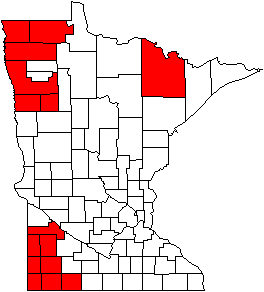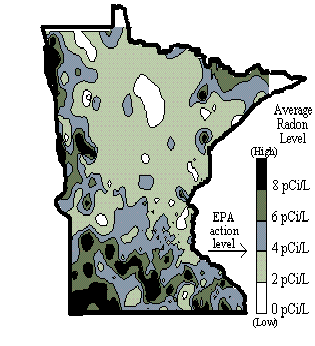Help for Homeowners in High Radon Areas

Shaded areas indicate counties targeted for 1995
What is the Minnesota Radon Project?
The Minnesota Radon Project is a nonprofit, public service
organization conducting radon research and educational outreach
programs. These efforts are supported by the US Environmental
Protection Agency (US EPA) and the Minnesota Department of
Health.
Why is my county targeted for radon study?
Your county has been identified as having "high" levels
of indoor radon. A "high" radon level exceeds the EPA's action
level of 4pCi/L. See the map below.
What is radon?
Radon is a radioactive gas generated by the decay of the uranium
that occurs naturally in all soils. Unlike natural
gas, you can't smell radon. In addition, radon's effects
are not as immediate as carbon monoxide poisoning.
Is radon a health risk?
Radon can be a health risk. When you breathe air that contains
high levels of radon, your chance of developing
lung cancer increases.
Where am I being exposed to radon?
While radon is present everywhere, your home usually contains
more radon than workspaces or outdoors.
How does radon get into my home?
Radon enters through the foundation or crawl space. Common
entry points are sumps, drains, cement block basement walls and
dirt crawl spaces.
Does my home have high radon?
The only way to know for sure is to test your home. The map below
will give you a rough estimate of the
indoor radon concentrations in your county. Keep in mind
that high radon houses can be found anywhere in Minnesota.
Contact the Minnesota Radon Project (1-800-820-3209) or the
American Lung Association of Minnesota for a test kit.
Can anything be done about radon?
Indoor Radon Levels in Minnesota

Yes. Most Minnesotans can significantly reduce their radon
exposure without spending large sums of money.
Indoor Radon Levels in Minnesota The map shown above is based
on over 30,000 homowner-made radon measurements. The blue, green, and
black areas show where the average radon is expected to
exceed the EPA action level. The accuracy of this map has been
checked using scientific surveys in over 50 towns. Dr. Dan
Steck, nuclear physicist and director of the Minnesota Radon
Project, conducted these scientific surveys during the period
1983 to 1993. If you know the radon level in your home, please
call us. We'd like to check your results against the prediction
of this map. The EPA has also published a
map that shows
Minnesota with regions of high and moderate radon Their high
radon potential counties roughly correspond to the darker areas
on our map.
Scientific measurements show that:
- Homes that exceed the EPA's recommended action level of 4pCi/L
are found throughout Minnesota.
- Approximately 40% of all Minnesota homes have living spaces
above the action level.
- Approximately 3% of all Minnesota homes have living spaces with
higher radon levels that those allowed for uranium mines.
- Homes have been found in Minnesota with radon levels 25 times
higher than the EPA's action level.
How Can the Minnesota Radon Project Help Me?
The Minnesota Radon Project searches for homes with high indoor
radon concentrations in order to help homeowners reduce their
exposure to this serious radiation hazard. If you don't know
your radon levels we can help you by testing your home. If you
do know the radon levels in your home we can inform you on the
implications of those levels and offer advice on actions you may
be considering to respond to your levels.
If you want to measure the radon levels in your home, the
Minnesota Radon Project will provide a free radon detector kit
to the first twenty homeowners in each targeted county that
contact us. If you are not one of the first twenty to call, we
will have additional detector kits available at cost. When the
postage-paid kit is returned, we analyze the detector and send
you a confidential report detailing the results. We include
information to help you interpret the results. After you receive
your report, you can call our toll free number for assistance.
If you know the radon level in your home, we can help you to
decide on a course of action. While the Minnesota Radon Project
does not provide mitigation services, we can give you the names
of contractors who have participated in the EPA's Radon
Contractors Proficiency (RCP) program. If there are no RCP
mitigators nearby we could serve as a liaison between a group of
homeowners who want to mitigate and a RCP mitigator who is
willing to travel to rural areas. We can also help homeowners
who want to try to mitigate their homes themselves.
Any individual who wants radon information can call our toll
free number. Any group who would like to hear and see a
presentation on radon tailored to their group's interest, please
contact Dr. Steck to make arrangements.
Radon: The Facts That Will Make You Take Action.
- Radon is the largest source of radiation exposure for most
Minnesotans.
- All Minnesota homes contain radon. Some Minnesota homes contain
more radon than allowed in uranium mines.
- The US Environmental Protection Agency
has called indoor radon the most deadly
indoor pollutant and the second leading cause of lung cancer.
- A lifetime's exposure to radon in many Minnesota homes
significantly increases the risk of dying from lung cancer.
- Radon travels only a few feet through the
soil before it enters a home. Individual
houses, neighborhoods, or entire towns can have radon problems.
- Most Minnesotans can reduce their radon exposure simply and
inexpensively.
Radon can be deadly--let the Minnesota Radon Project help make
sure that you
do not become one of its victims because
you didn't know.
1995 Targeted Counties
Northwestern Minnesota
- Norman
- Mahnomen
- Polk
- Marshall
- Kittson
- Roseau
- Northern St. Louis
Southwestern Minnesota
- Rock
- Nobles
- Jackson
- Murray
- Pipestone
- Lincoln
- Lyon
- Yellow Medicine
Information
The Minnesota Radon Project
1-800-820-3209 or
(320)-363-3186 or
e-mail:
radon@csbsju.edu
http://www.physics.csbsju.edu/MNradon
Minnesota Department of Health
612-215-0909
American Lung Association of Minnesota
612-227-8014
Back to Current Projects
 Back to the MRP Homepage
Back to the MRP Homepage

